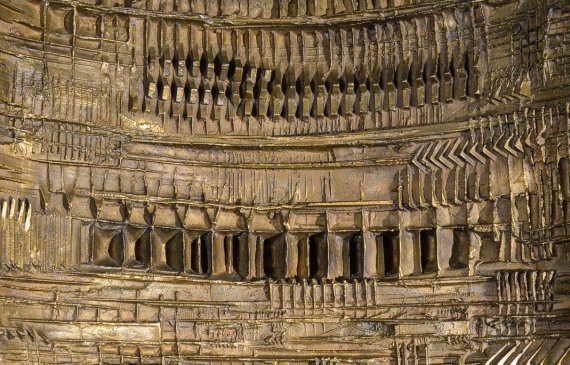




Arnaldo Pomodoro (Italian, b. 1926)
Successioni n. 2, 1962
Bronze
55 ½ H. x 25 W. x 8 ½ D. inches
Mounted on painted steel base: 10 ½ H. inches
Edition of 2, both unique
Catalogue Raisonné No: AP 206b 2
Provenance:
The Artist
Private Collection, Chicago Illinois, circa 1965
Exhibitions:
Los Angeles, Felix Landau Gallery, Recent Sculptures by Arnaldo Pomodoro, October 29 – November 17, 1962.
Brussels, Palais des Beaux-Arts, Arnaldo e Gio Pomodoro, February 22 – March 16 1963.
New York, Marlborough-Gerson Gallery, Arnaldo Pomodoro, October – November 13, 1965.
Arnaldo Pomodoro is an Italian sculptor who lives and works in Milan. Before he turned to sculpture he served as a consultant for the restoration of public buildings that had been destroyed in World War II in Pesaro, while also training as a goldsmith and studying set design. In 1954 Pomodoro moved to Milan where he became acquainted with artists such as Lucio Fontana, Sergio Dangelo, and Enrico Baj. That same year he exhibited his work for the first time at the Galleria Montenapoleone in Milan, and the Galleria Numero in Florence.
While touring Europe in 1959 Pomodoro befriended Alberto Giacometti and Georges Mathieu. He then went to the United States where he organized exhibitions of contemporary Italian art at the Bolles Gallery in New York and San Francisco. Upon his return to Italy he founded the Continuità group, whose members included Fontana and Arnaldo’s brother, Giò Pomodoro. During his time with this coterie of abstract artists Pomodoro became focused on five shapes that would go on to define his oeuvre: the sphere, the column, the pyramid, the disc, and the cube.
Drawing on his beginnings in metalwork, Pomodoro works in bronze, excavating simple forms to reveal complex internal and external geometries. Renowned for his outdoor public installations, it was in the 1960s that Pomodoro began producing large, freestanding sculptures on an urban scale. Successioni n. 2 is exemplary of his work from this period. Here, the artist experiments with hallowing out a half section of a column to reveal an interior textured with intricate geometric pattern. Pomdoro’s sculptures often play with the contrast between smooth and textured forms. His highly polished surfaces are split open to expose innards lacerated with varying intensity. He says of his work, “I see them as relating to borders and voyages, to the worlds of complexity and imagination.” Pomodoro is unconventional in his insistence on partaking in the fabrication in his work.